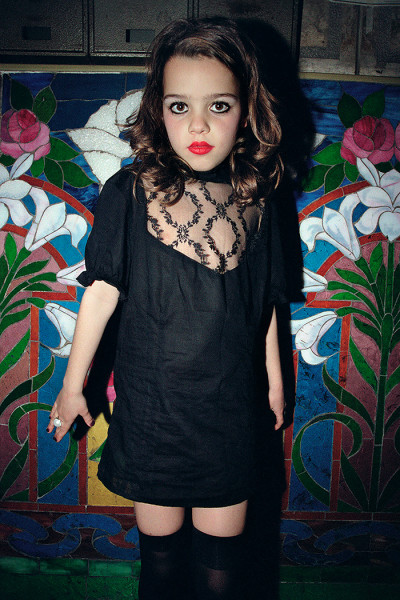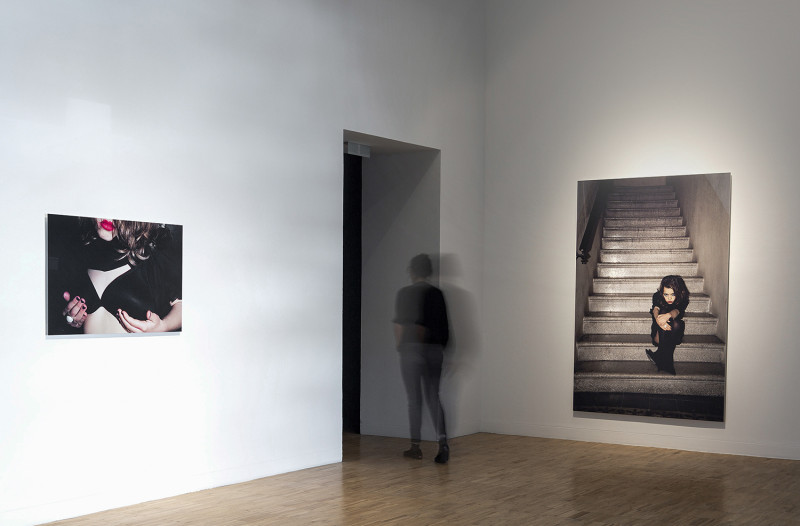Yapci Ramos
Lolita, 2010
The photographic series Lolita, of which an image is presented in Show Me, the artist’s recent museum exhibition in Tenerife, is singular, authentic, powerful, courageous —and beautiful. With Lolita, Ramos brings “hidden things to the surface,” as she herself says. The pictured girl, freely, upon her own initiative, used the artist’s clothes, shoes, makeup. “I saw her and captured those moments when she was wondering, as all children do, ‘Where do I belong?’ ”Lolita is also Yapci Ramos herself, just as she is thousands of little girls from yesterday and today, curious about the world around them, about what they understand and what they do not, girls who want to play,with impunity, with all the possibilities one can imagine. The Albanian artist and writer Ornela Vorpsi expresses it well: “I did not create the world into which I was placed.” What could be more normal, then, to want to explore the world, to understand its systems and mechanisms, to experience all that is possible? In order to determine—and possibly create—the world “where I belong,”“I” need to understand what has happened, to know the rules, and to decide whether I want to follow those rules or “break” them.
Yapci Ramos is one of the few female artists today who dare show the way (little) girls play with their sexual identity and to expose the possibility that their sexuality exists. Lolita captures our attention, our projections, our desires, our images of what a girl’s sexuality should or should not be. How can children’s sexuality exist when, according to current norms, it should not? As if little girls (and little boys) were genderless, with no sexual organs, as if they did not explore them, as if they did not try to understand the pleasure they could procure. Yes, sexuality exists during childhood, one that belongs to the children themselves, and shamed be the one who thinks evil of it. Yes, children have their own sexuality, and Yapci Ramos asks the question “What is the right age?” without answering it: art is there to make us think rather than to provide answers. Whatever the right age however, adults have to respect the children and their sexuality without playing the voyeur-avenger.
With this photographic series, Ramos takes important risks and pursues an essential goal. The essential goal is to give back her childhood privacy to all Lolitas and hence to us, the viewers. And the risk? That of being labelled one day, like Irina Ionesco, a “perverse photographer,” discredited, judged, banished. But Yapci Ramos uses this ordalic risk as raw material for creating. Ramos states, however, that her Lolita gave only what she wanted. “I never asked for this or that. She gave me the space to photograph her, to photograph her power of attraction. She gave it to me. I saw it and took it.”
Lolita, at age eight, is a “little girl.” While the spectators’ gaze tends to objectify her, Ramos insists, through her images, that Lolita is, she exists, she tries to exist in different ways. Ramos’ Lolita does not provoke but searches: she looks for how her clothes, her “stuff,” her makeup, her attitudes, the roles she plays, might express what she searches to discover in herself. Look at her, admire her, this small person, rebellious and courageous, who braves our suspicious gaze, a gaze that sees sexualisation while the child is searching for her identity.
Do not approach her, do not touch her, do not spy on her, do not tell her she is beautiful or that she is breaking the rules. Leave her in peace, because she is in no way searching for a sexual connection; she is searching for herself. Ramos reveals all this with her images, which are almost “self-filles” or “selfies,” speaking to us, adults who have forgotten how we wanted to be, whom we admired, whom we wanted to be and why. Fortunately, Yapci Ramos reminds us of the reality of a child, of a wild child who lives a child’s life according to codes of a child in search of him- or herself. “Let the little children come to them”2; look at this “becoming” but without intervening; keep your distance. Ramos generates this gaze from a distance, the distance of respect, while mentioning that “she enjoys putting herself on display as much as we enjoy looking at her.”
Essay by Barbara Polla, Swiss medical doctor, gallerist, art curator and writer.




